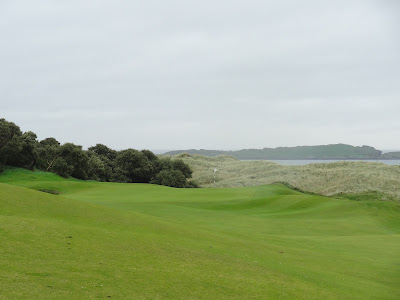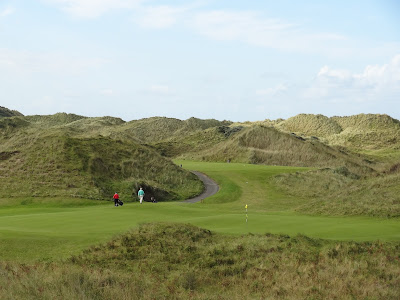Theresa and I are now safely home, our wonderful Fortnight in Ballyliffin TM sadly behind us. We arrived home Saturday afternoon, but I'll continue to post a last couple of items as if plausibly live.
The trip itinerary contemplated mitigating the disappointment of leaving Ballyliffen with the thrill of revisiting Royal Portrush for our final round of golf. Alas, our pact with the weather devil lapsed on the 18th green at Portstewart and we played through a very difficult day at the wonderful and dramatic Dunluce links, Theresa's favorite course in all of linksdom. Because of the weather, I'll use photos from both this trip as well as our two pervious rounds there in 2008.
Let me first dispense with the score keeping... for a number of reasons, including the rain (there were no entries on our scorecard after the fifth hole, my shin splints, the general quality of play as well as the fact that we never actually consulted the separate women's card we were handed in the golf shop but noted halfway through the round that Theresa was playing an extremely long golf course of indeterminate par, we quickly lost the plot of and interest in our match. So, lets' consider the trip to have been halved and talk about the spectacular Dunluce Links of The Royal Portrush Golf Club.
The club dates back to 1888, when it was first known as The County Club and featured a rudimentary nine hole course. It became the Royal County Club when the Duke of York become the club's patron in 1892. It finally became Royal Portrush Golf Club in 1895 when H.R.H. Prince of Wales (later King Edward VII) became the club's patron.
Portrush itself is an erstwhile fishing village a little more than an hour from Belfast that has transformed itself into a major resort town, with attractive beaches and in close proximity to the major tourist attractions on the Antrim coast such as the Giant's Causeway and the Carrick-a-Rede Rope Bridge. Just West of town are the runis of the Dunluce Castle, from which the links take their name.
Royal Portrush has the distinction of being the only club to host an Open Championship outside mainland Great Britain, which occurred in 1951. While that undoubtedly contributes to its bona fides, it is by now beside the point. The Dunluce is simply one of the great links to be savored, on that very short list with the Royal County Downs, Murifields and Ballybunions of the world. Designed by Harry Colt in 1929, it benefits from dramatic terrain and wonderful views of the breathtaking white rock cliffs, but is also one of the sternest tests to be found.
As touched on above, this is one of the most difficult links for the amateur golfer, as the playing corridors are narrower than is typical and the rough is quite virulent. There are also more and larger gorse bushes in play, no-go zones to the experienced links player. But in my mind, the course contains a couple of two hole sequences that are beyond comparison, with each shot providing a unique examination for the player accompanied by no shortage of eye candy.
The first of these is in the middle of the outbound nine, specifically the fourth and fifth holes. The fourth, named Fred Daly's after the Portrush native who until Graeme McDowell's breakthrough in 2010 was the only Ulsterman to have won a major, the 1947 Open Championship at Hoylake. It's not like the citizens of Northern Ireland took any pride in that victory, but to this day 1947 remains the combination to the restrooms at the turn. The fourth is a long Par 4, 479 yards from the Tiger tees but a still robust 442 yards from the Society tees.
It's an exacting tee shot, with OB right and three deep fairway bunkers to penalize the many players that put their best "Not Right" swing on the tee ball (ahem, including the author this time through). From the fairway, the approach must be equally precise, a mid to long iron to a green nestled between two dunes, which I find very reminiscent of the famed 11th at Ballybunion. Any shot finding the dunes will provide a challenging up and down, especially if the miss is on the short side.
 | ||||
| The fourth green, top, and looking back down the fairway from behind the 4th green, bottom. |
The fifth, called White Rocks, is the more famed of the two holes, but provides a completely
different test for the player. The hole is significantly shorter (only
369 yards from the Society tees) and plays downhill and usually downwind
as well, but the challenge comes from the severe dogleg right shape of
the hole, requiring the player to choose his line with utmost care. If one bites off too much of the dogleg or runs it through the fairway, it makes the delicate second a treacherous shot.
If one finds the fairway, one is left with a reasonably short pitch into a double plateau green, made more nerve racking by the visual reminder that any shot running through the green will be troubling. It's only when you finish the hole and look back that the player typically realizes that the hole features exactly no bunkers.
The second sequence of holes worth noting is the thirteenth and fourteenth, this time a Par 4 and 3, respectively.
Thirteen is a short Par 4 called Skerries, named for a small
offshore grouping of rocky islands, only 358 yards from the Society
tees. It
plays up and over a large dune, the only time Colt's routing uses the
dunes for such a purpose. and all but the shortest of hitters can reach
the crest of the hill. The author got all of his drive, and had the
pleasure of watching it take a humongous bounce and disappear from view,
only to find it less than sixty yards from the green.
But that's where Colt makes it uniquely interesting, as the contours of the ground make it a devilishly difficult pitch or bump and run to get close. There are two bunkers protecting the left side of the green, so the obvious instinct is to play safely away from them. But the right side of the green features an extremely steep face on the collar, which will prevent most balls that land into it from releasing onto the green. Thus the player has to either land it short and run it up, or carry the steep face and hope his shot holds on a green that subtly runs away.
As with the previously discussed fifth hole, Colt's routing has play turn back inland and into the prevailing wind, in this case one of the world's best known one-shotters, Calamity Corner, often incorrectly shortened to the simpler Calamity. The fourteenth is one of the most difficult Par 3's in golf, a 200 yard carry into the wind across a deep chasm, with the contour of the ground pushing any shot that doesn't reach the green towards the ravine that must be fifty to sixty feet deep.
There is a depression to the left of the green which is the obvious bailout spot for players. It's known as Bobby Locke's Hollow, after the famed South African player who deliberately played to there in all four rounds of the 1951 Open Championship, and made his par all four times. Of course, when you putt as well as Bobby Locke, who many experts consider the best putter ever, you can deliberately miss greens.
One other quick note about Royal Portrush. The seventeenth and eighteenth are notoriously less interesting than that which precedes them. They are difficult good golf holes, they just happen to play over terrain far less interesting than than most of the routing. It should be noted that this is a common phenomenon in linksville, as clubhouses are invariably located close to roads and it is often a simple matter of geography that it takes the architect a hole or two to move the players towards the water and/or out into the dunes.
However, the routing here is a little different, as No. 16 takes you back almost to the clubhouse, and seventeen takes you past it towards town, with eighteen bringing you back between the clubhouse and the starter's shack. For many years Lowell has been chewing my ear off that they should start play on No. seventeen, and finish on the very good No. sixteen. Completely unsolicited, my caddy George, an experienced Portrush looper, advocated the same routing.
On final note for now, In my last post from Ballyliffin, i noted the eerie coincidence that on both trips rain resulted in us skipping our last hole, leaving us craving more. Similarly, the heavy rains on the last day paralleled our 2008 trip, where we got absolutely pummeled on Royal County Down. This necessitated emptying everything out of our golf bags in an attempt to dry them before packing them for travel, and completely trashing our small hotel room.
 |
| Our hotel room at the Park Plaza Belfast. Only a great suggestion by Lowell, to use the hotel hardryer, helped us avoid shipping our gear home soaking wet. |
By way of comparison with life at home, Theresa just loved this hotel. It's an airport hotel where we never heard a single airplane, can see the beautiful Irish Sea from our third floor room and the from our window included horses and cows. Oh, and in the morning (but fortunately not too early) we woke to the sound of a rooster. Just like JFK, no?

















































